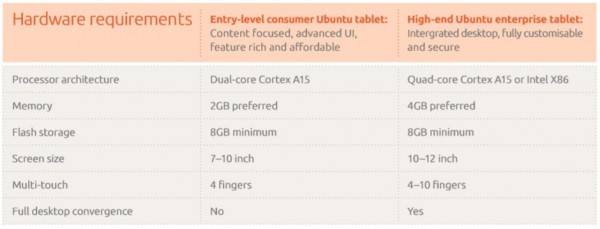Ubuntu tablet challenges Android, BlackBerry, iOS and Windows
Developers looking for Ubuntu on smartphones will get a second treat on February 21. Today, Canonical revealed a build for tablets. Supported testing devices for both platforms: Galaxy Nexus, Nexus 4, Nexus 7 and Nexus 10. Ubuntu replaces Android, not runs alongside or dual-boots with it.
"Ubuntu tablet" supports multi-touch slates running dual-core ARM A9 processor with 1GB of RAM and 8GB storage. However, Canonical's ambitions are greater for commercially-shipping products: dual-core A15 processor and 2GB RAM for 7-to-10 inch tablets and quad-core A15 or x86 processor and 4GB of RAM for 10-to-12 inch slates. The specs reveal plans to compete with touch ultrabooks or tablet hybrids like Microsoft Surface Pro. The operating system supports up to 20-inch tablets. However, lower-end tablets will be a priority.
Like Apple, Google or Microsoft, Canonical talks a four-screen strategy. In October 2011, CEO Mark Shuttleworth promised Ubuntu would appear on smartphones, tablets and TVs, in addition to PCs. The company formally announced the smartphone OS in January.
The difference: Canonical claims a unified user experience across devices. None of the aforementioned competitors deliver that today, although Google is closest. "The tablet is the next step in our mission to create one unified experience for all personal computing", Shuttleworth boasts.
Related: Canonical touts a write-once, run-on-any-device benefit for developers. Again, Google is closest to offering something similar. Information about the Touch Developer Preview for phones and tablets already is available, as well as a preview SDK. To reiterate: Software releases Thursday.
"We have both rich native applications and web applications that run side-by-side as equal citizens on the tablet", Shuttleworth says.
While the first commercial smartphones and tablets are expected this year, Canonical doesn't plan to unify all form factors into a single platform until 14.04 LTS releases early next year. Ubuntu will be the same across devices, but not the user interface. For example, on smartphones the UI is primed for one-handed operations and two on tablets. Says Shuttleworth about phones: "All the goodness of Ubuntu perfectly shaped to your hand".
Like Android, Ubuntu tablet supports multiple users, and like Chrome OS a guest mode. Favorite apps launch from a left-pull toolbar, and a swipe opens the full apps page. "Swipe through the right edge and you reveal phone apps running on your tablet", or The Sidestage, Shuttleworth says. Split-screen presents phone and tablet apps running side-by-side.
The Sidestage and right-top pull-down menu also let users socially interact or access additional services while maintaining the larger content menu for, say, watching a movie.
Ubuntu tablet supports modular designs. A phone docked to a slate displays content in The Sidestage, while the tablet becomes a PC with mouse and keyboard.

Canonical expects OEMs to ship devices running Ubuntu tablet, although partners announcements, along with chipsets, are forthcoming. Support for Nexus devices is meant for developers, but judging from the reaction I see on social networks, gadget geeks will grab and mod, too.
"I want an Ubuntu tablet now!" Christopher Bowley posts to Google+. "Don't even need a desktop/laptop anymore. Assuming it's as powerful as the desktop os, which seems like the case. As long as it has external USB support. My external drive, phone, and Tascam pocket studio (which connects as an external drive) is all I need to connect. Seems doable".
Brett Daugherty: "Liking the +Ubuntu tablet. Gonna flash my phone to the mobile OS Thursday to give that a shot, wouldn't mind being able to flash my tablet to that too to get the full experience".
Will you, too?
